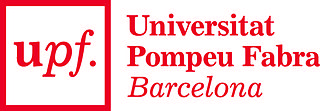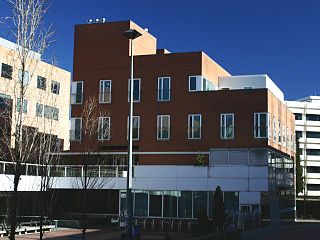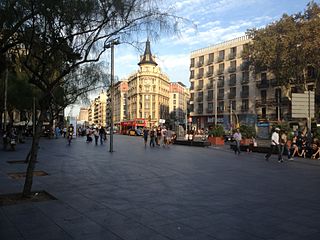The University of Barcelona is a public university located in the city of Barcelona, Catalonia, in Spain. With 63,000 students, it is one of the biggest universities in Spain. It is one of the oldest universities in both Catalonia and Spain, established in 1450.

The Technical University of Catalonia, currently referred to as BarcelonaTech, is the largest engineering university in Catalonia, Spain. It also offers programs in other disciplines such as mathematics and architecture.

Pompeu Fabra University is a public university located in the city of Barcelona, Catalonia in Spain. The university was created by the Autonomous Government of Catalonia in 1990 and was named after Pompeu Fabra. UPF has been ranked the best university in Spain since 2015 and 16th best young university in the world in 2022 by the Times Higher Education World University Rankings.

The Open University of Catalonia is a private open university based in Barcelona, Spain.

Estadi Olímpic Lluís Companys is a stadium in Barcelona, Catalonia, Spain. Originally built in 1927 for the 1929 International Exposition in the city, it was renovated in 1989 to be the main stadium for the 1992 Summer Olympics and 1992 Summer Paralympics. It will be the home stadium of FC Barcelona for the 2023–24 season due to the renovation of their regular ground, Camp Nou.

The Principality of Catalonia was a medieval and early modern state in the northeastern Iberian Peninsula. During most of its history it was in dynastic union with the Kingdom of Aragon, constituting together the Crown of Aragon. Between the 13th and the 18th centuries, it was bordered by the Kingdom of Aragon to the west, the Kingdom of Valencia to the south, the Kingdom of France and the feudal lordship of Andorra to the north and by the Mediterranean Sea to the east. The term Principality of Catalonia was official until the 1830s, when the Spanish government implemented the centralized provincial division, but remained in popular and informal contexts. Today, the term Principat (Principality) is used primarily to refer to the autonomous community of Catalonia in Spain, as distinct from the other Catalan Countries, and usually including the historical region of Roussillon in Southern France.

The Barcelona Museum of Contemporary Art is a contemporary art museum situated in the Plaça dels Àngels, in El Raval, Ciutat Vella, Barcelona, Catalonia, Spain. The museum opened to the public on November 28, 1995. Previous directors include Daniel Giralt-Miracle (1988–1994), Miquel Molins Nubiola (1995–1998), Manuel J. Borja-Villel (1998–2007), Bartomeu Marí (2008-2015), and Ferran Barenblit (2015-2021), while the current director is Elvira Dyangani Ose.

The Barcelona School of Informatics is one of the schools of the Universitat Politècnica de Catalunya, Spain. It was created in 1976, four years after the establishment of the university.

Gran Via de les Corts Catalanes, more simply known as Gran Via[ˈɡɾam ˈbi.ə], is one of Barcelona's major avenues. With a length of 13.1 km (8.1 mi), it is the longest street in Catalonia and the 2nd longest in Spain, after Gran Vía de la Manga, in La Manga del Mar Menor, but is the one with most street numbers in Spain.
Barcelona Metro line 11 is a light metro line with short trains in Barcelona, Catalonia, Spain.

Estació de França is a major railway station in the city of Barcelona in Catalonia, Spain.

The Barcelona–Vallès Line is an unconnected standard gauge rapid transit and commuter railway line linking Barcelona with Sabadell and Terrassa via the Collserola mountain range, in Catalonia, Spain. Its name refers to the Catalan historical region of Vallès, whereby most part of the line runs. Plaça de Catalunya station serves as the Barcelona terminus of the line, where almost all its trains either start or terminate. The line then continues northwards and branches off twice before leaving the city limits. Its main route splits in two in Sant Cugat del Vallès, forming two major branches to Sabadell and Terrassa. It has 40 passenger stations in operation and a total line length of 48.1 kilometres (29.9 mi).

Ronda de la Universitat is a major thoroughfare of central Barcelona, Catalonia, Spain, in lower side of the Dreta de l'Eixample, in the Eixample district. It links two of the city's three main squares, running from Plaça de Catalunya towards Plaça Universitat. There it meets Gran Via de les Corts Catalanes and Ronda de Sant Antoni begins. It's essentially the same street as Ronda de Sant Pere, which follows it right after Plaça de Catalunya. As the other ronda, it follows the original outline of the medieval city walls, particularly the wall of Tallers, above the area nowadays known as Raval, where a road called Carrer de Tallers runs partially parallel to it. Ronda de la Universitat was paved in 1872. It takes its name from the Universitat de Barcelona, which has had its main building at Plaça Universitat since the 19th century. Before its current name was approved in 1989, its official name was in Spanish: Universidad. The Biblioteca Judicial de Catalunya is on this street.

La Vila Olímpica del Poblenou or La Villa Olímpica is a neighborhood in the Sant Martí district of Barcelona, Catalonia (Spain). It was constructed in the late 1980s and early 1990s for the 1992 Summer Olympic Games which took place in Barcelona. Its construction was devised by Oriol Bohigas, David Mackay and Albert Puigdomènec as a residential area in the otherwise industrial and working-class district of Poblenou, which underwent regeneration but involved massive expropriation, as well as the destruction of a sizeable portion of the district, including Industrial Revolution factories of architectural value such as Fàbrica Foret. It follows essentially the reticular outline of Eixample and Poblenou, with about 2000 new apartments in the area, owned by the mixed public-private company VOSA.

The University of Lleida is a university based in Lleida, Catalonia, Spain. It was the first university founded in Catalonia and in the ancient Crown of Aragon. It was founded in 1300, using the name of Estudi General de Lleida.

The School of Industrial Engineering of Barcelona is a university school that is part of the Universitat Politècnica de Catalunya.

The Monastery of Pedralbes is a Gothic monastery in Barcelona, Catalonia, Spain. It is now a museum, housing permanent exhibitions on its own art and legacy as well as third-party special exhibitions from time to time. The Chapel of St. Michael was restored and re-opened in 2018.

Abat Oliba CEU University is a private university located in Barcelona, Spain. It was founded in 1973 as the Abat Oliba College. In 2003, the Parliament of Catalonia approved its conversion to Abat Oliba CEU University. The university adopts the name of Abbot Oliba, Count of Berga and Ripoll, bishop of Vic, and founder of Montserrat because "aimed at making its spirit who established a thousand years the foundations of emerging Catalonia based on Roman and Christian culture".

The University of Vic - Central University of Catalonia (UVic-UCC), is a Catalan university with premises in Vic, Manresa and Granollers. It is a privately managed institution, under public supervision through its proprietor, the Balmes University Foundation, whose chair is the Mayor of Vic. UVic-UCC is a higher education and research centre. The UVic-UCC is a member of the Vives University Network.

















